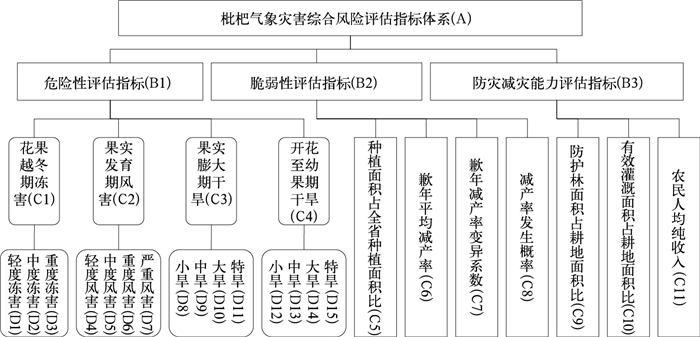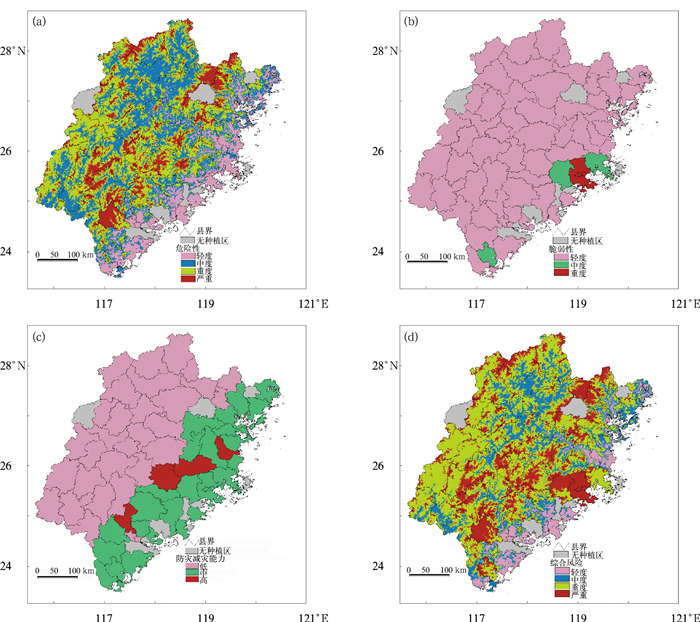Integrated Risk Evaluation on Meteorological Disasters of Loquat in Fujian Province
-
摘要: 通过辨识影响福建省枇杷生长发育和产量的主要致灾因子,分析枇杷对气象灾害的敏感性和暴露性,考虑种植区的防灾减灾能力,构建出枇杷气象灾害综合风险评估指标体系,利用枇杷种植区1971—2011年气象资料,1992—2011年枇杷种植面积、产量及其他社会经济资料,采用层次分析法和熵权系数法融合方法计算各风险指标的权重及各评估单元的风险指数,进而构建枇杷气象灾害的综合风险评估模型,应用GIS技术制作出风险精细区划图,评估枇杷气象灾害的综合风险。结果表明:致灾危险性对综合风险的影响最大,起主要作用;重度以上的综合风险主要分布在福建省5个主要山脉的中高海拔山区以及枇杷种植面积大的莆田市、福清市、云霄县,轻度综合风险区主要分布在中南部沿海县市的低海拔种植区 (除种植大县和东山县外),其余种植区的综合风险属中度。Abstract: In order to identify the risk of loquat growing on complicated terrain in Fujian Province, to avoid planting in high risk areas, integrated risk evaluation on meteorological disasters of loquat in Fujian Province is conducted using disaster risk analysis theory. A risk evaluation index system for meteorological disasters of loquat in Fujian Province is constructed, based on the identification of the major disaster-causing factors affecting loquat growth and yield, and from the analysis of the sensitivity and exposed property of loquat to meteorology disasters, and the disaster prevention and mitigation capability of loquat growing regions in the Province. In addition, the risk index of each evaluation unit is calculated based on the annual meteorological data, loquat planting areas and yield, and other socio-economic data in loquat growing region in Fujian Province, and by using the weight of risk indices determined by analytic hierarchy process method and entropy weight coefficient method. Therefore, an integrated risk evaluation model of meteorological disasters is established and a fine risk division map is drawn with GIS technique. The growing region is divided into four-risk-grade areas, including mild risk area, moderate risk area, severe risk area and severity risk area. The result shows that, from the aspect of risk factors composition for the meteorological disasters of loquat, potential hazard of the disaster-causing factors is the determinant factor influencing the synthetic risk, the vulnerability of the planting area takes the second place, and the damage prevention and mitigation capacity only plays an alleviative role. In the Province, loquat growth regions with severe and more severe integrated risk of meteorological disasters for planting loquat are mainly distributed in the mountain areas with mid-high elevation of the five major mountain ranges, and counties with large growing areas including Putian City, Fuqing City and Yunxiao County; the regions with light integrated risk are mainly in the coastal counties with low elevation in the middle south of the Province (except large planting counties and Dongshan County); and the regions with moderate integrated risk are distributed in the other areas of the Province. Based on the risk evaluation results combined with loquat damage examples in history, it could be verified that the risk evaluation and division results is consistent with the actual situation. The results could offer scientific basis for the adjustment and optimization of loquat planting distribution, and for reducing the integrated risk of loquat planting in Fujian Province.
-
Key words:
- loquat;
- meteorological disasters;
- risk evaluation
-
表 1 致灾因子危险性等级
Table 1 Hazard level of disaster-causing factors
致灾因子 危害等级 轻度 中度 重度 严重 花果越冬期极端最低气温td/℃ -3.0≤td < -2.0 -5.0≤td < -3.0 td < -5.0 果实发育期日最大平均风速v/(m·s-1) 10.8 < v≤17.2 17.2 < v≤24.5 24.5 < v≤32.6 v > 32.6 果实膨大期连旱日数dsd/d 16≤ dsd≤30 31≤ dsd≤45 46≤ dsd≤60 dsd > 61 开花至幼果期连旱日数dad/d 31≤ dad≤50 51≤ dad≤70 71≤ dad≤90 dad≥91 注:连旱日数是指日降水量不大于2 mm的连续日数;当果实膨大期、开花至幼果期日降水量不大于2 mm的连续日数分别达到16 d和31 d时开始出现干旱,并统计旱日;其后出现连续6 d降水量不小于30 mm (果实膨大期) 或不小于15 mm (开花至幼果期) 则解除旱情,终止旱日统计,若未达解除标准,持续统计连旱日数。 表 2 枇杷气象灾害风险指标综合权重值
Table 2 Comprehensive weight of the risk evaluation index for loquat meteorological disasters
二级指标 二级指标权重 三级指标 三级指标权重 四级指标 四级指标权重 B1 0.6292 C1 0.5473 D1 0.0563 D2 0.1733 D3 0.7704 C2 0.3456 D4 0.0314 D5 0.1075 D6 0.3560 D7 0.5051 C3 0.0897 D8 0.0136 D9 0.0546 D10 0.1644 D11 0.7644 C4 0.0174 D12 0.0705 D13 0.2016 D14 0.1584 D15 0.5695 B2 0.3573 C5 0.9159 C6 0.0250 C7 0.0165 C8 0.0426 B3 0.0135 C9 0.7157 C10 0.1493 C11 0.1350 表 3 枇杷气象灾害综合风险归一化评估指数
Table 3 Normalized difference index of the synthetic risk evaluation for loquat meteorological disasters
评估单元 危险性 脆弱性 防灾减灾能力 综合风险 光泽 0.7505 0.0660 0.1885 0.7653 邵武 0.3661 0.0587 0.2068 0.3852 武夷山 0.2851 0.0590 0.1212 0.3081 浦城 0.4148 0.0610 0.1889 0.4344 建阳 0.2980 0.0591 0.1680 0.3197 松溪 0.2734 0.0537 0.1672 0.2926 政和 0.1167 0.0662 0.0537 0.1491 建瓯 0.1752 0.0687 0.2070 0.2044 寿宁 1.0000 0.0467 0.0978 1.0000 周宁 0.5299 0.0359 0.0245 0.5360 福安 0.0418 0.0818 0.4236 0.0769 福鼎 0.0560 0.0520 0.5160 0.0717 宁化 0.5109 0.0561 0.1002 0.5274 清流 0.3602 0.0543 0.1785 0.3774 泰宁 0.6805 0.0539 0.1608 0.6906 将乐 0.1188 0.0507 0.1799 0.1396 顺昌 0.1349 0.0554 0.1892 0.1578 明溪 0.3976 0.0398 0.1154 0.4070 沙县 0.0890 0.0619 0.2366 0.1156 三明 0.0454 0.0576 0.1920 0.0716 南平辖区 0.0334 0.0673 0.1798 0.0656 古田 0.0982 0.0423 0.3728 0.1105 尤溪 0.1619 0.0690 0.1788 0.1921 闽清 0.0338 0.0467 0.4411 0.0486 霞浦 0.0415 0.0914 0.5554 0.0794 闽侯 0.0263 0.0733 0.6468 0.0522 罗源 0.0336 0.0667 0.5259 0.0581 宁德辖区 0.0026 0.0697 0.6289 0.0273 福州辖区 0.0348 0.0624 0.9967 0.0467 连江 0.0170 0.0810 0.5382 0.0498 长汀 0.1845 0.0591 0.0780 0.2108 连城 0.0716 0.0490 0.1384 0.0933 武平 0.0771 0.0478 0.1353 0.0981 上杭 0.0348 0.0546 0.1186 0.0610 永安 0.0783 0.0558 0.1976 0.1025 大田 0.1022 0.0724 0.1174 0.1371 漳平 0.0557 0.0387 0.1866 0.0708 龙岩 0.0275 0.0536 0.2737 0.0500 华安 0.0558 0.0536 0.9458 0.0632 安溪 0.0286 0.0462 0.6393 0.0390 永泰 0.0317 0.0915 0.8950 0.0626 永春 0.0510 0.1261 0.5445 0.1088 德化 0.1149 0.0492 1.0000 0.1173 仙游 0.0693 0.3427 0.4565 0.2529 长乐 0.0276 0.0480 0.4112 0.0439 福清 0.0586 0.2805 0.4701 0.2065 莆田 0.0533 1.0000 0.3927 0.6160 永定 0.0591 0.0465 0.1845 0.0787 长泰 0.0662 0.0549 0.4760 0.0842 南靖 0.6492 0.0609 0.5266 0.6563 平和 0.0885 0.0599 0.5299 0.1077 漳州辖区 0.0998 0.0495 0.2706 0.1183 漳浦 0.1246 0.0597 0.4788 0.1440 南安 0.0647 0.0659 0.4706 0.0892 惠安 0.1251 0.0591 0.3829 0.1462 厦门 0.1291 0.0556 0.4252 0.1472 晋江 0.0888 0.0639 0.4705 0.1116 诏安 0.1366 0.0785 0.4081 0.1680 东山 0.3097 0.0553 0.3681 0.3247 云霄 0.1239 0.3628 0.5544 0.3156 表 4 致灾因子风险评估指数的地理推算模型
Table 4 Geographical calculation models of the risk evaluation for disaster-causing factors
评价指标 地理推算模型 复相关系数 检验值 C1 Ifi=-0.352+2.21×10-7x+5.46×10-8y+4.94×10-4h+5.96×10-7l 0.85 36.78* C3 Isdi=1.382-1.34×10-6x-5.74×10-8y-1.06×10-4h-2.46×10-6l 0.80 28.00* C4 Iadi=5.395+1.29×10-6x-2.04×10-6y-1.84×10-4h+1.53×10-6l 0.85 36.78* 注:*表示达到0.01显著性水平。 表 5 枇杷气象灾害综合风险评估模型
Table 5 Integrated risk evaluation models of loquat meteorological disasters
评价指标 评估模型 B1 Ih=0.5473Ifi+0.3456Iwi+0.0897Isdi+0.0174Iadi B2 Iv=0.9159Ipr+0.025Irr+0.0165Ivi+0.0426Icp B3 Ic=0.7157Isr+0.1493Iir+0.1350Ife A I=0.6292Ih +0.3573Iv-0.0135Ic 表 6 风险等级划分标准
Table 6 Grading standard of the risk
指标 风险等级 轻度 中度 重度 严重 B1 0≤Ih<0.10 0.10≤Ih<0.30 0.30≤Ih<0.50 0.50≤Ih≤1.00 B2 0≤Iv<0.10 0.10≤Iv<0.30 0.30≤Iv<0.50 0.50≤Iv≤1.00 B3 0≤Ic<0.35 0.35≤Ic<0.70 0.70≤Ic≤1.00 A 0≤I<0.10 0.10≤I<0.30 0.30≤I<0.50 0.50≤I≤1.00 表 7 涵江区部分乡镇枇杷园极端最低气温反演及冻害风险指数
Table 7 Minimum temperature retrieval and freezing injury risk indexes of loquat in parts of Hanjiang Region
时间 地点 海拔/m 枇杷冻害调查总体评价 园地百叶箱极端最低气温反演/℃ 露天极端最低温度反演/℃ 冻害危险性指数 2005-01-01 大洋乡 350 重度冻害 -0.8 -3.1 0.32 2005-01-01 庄边镇 320 中度至重度冻害 -0.6 -2.9 0.27 2005-01-01 新县镇 250 中度冻害 -0.1 -2.4 0.24 -
[1] 吴汉珠, 周永年.枇杷无公害栽培技术.北京:中国农业出版社, 2003: 5-9. [2] 郑少泉, 许秀淡, 蒋际谋, 等.枇杷品种与优质高效栽培技术原色图说.北京:中国农业出版社, 2005: 14-16. [3] 霍治国, 李世奎, 王素艳, 等.主要农业气象灾害风险评估技术及其应用研究.自然资源学报, 2003, 18(6):692-703. doi: 10.11849/zrzyxb.2003.06.007 [4] 葛全胜, 邹铭, 郑景云, 等.中国自然灾害风险综合评估初步研究.北京:科学出版社, 2008. [5] 刘荣花, 朱自玺, 方文松, 等.华北平原冬小麦干旱灾损风险区划.生态学杂志, 2006, 25(9):1068-1072. http://www.cnki.com.cn/Article/CJFDTOTAL-STXZ200609011.htm [6] 任义方, 赵艳霞, 王春乙.河南省冬小麦干旱保险风险评估与区划.应用气象学报, 2011, 22(5):537-548. doi: 10.11898/1001-7313.20110503 [7] 钟秀丽, 王道龙, 李玉中, 等.黄淮麦区小麦拔节后霜害的风险评估.应用气象学报, 2007, 18(1):102-107. doi: 10.11898/1001-7313.20070118 [8] 朱琳, 叶殿秀, 陈建文, 等.陕西省冬小麦干旱风险分析及区划.应用气象学报, 2002, 13(2):201-205. http://qikan.camscma.cn/jams/ch/reader/view_abstract.aspx?file_no=20020226&flag=1 [9] 罗伯良, 黄晚华, 帅细强, 等.湖南省水稻生产干旱灾害风险区划.中国农业气象, 2011, 32(3):461-465. http://www.cnki.com.cn/Article/CJFDTOTAL-ZGNY201103023.htm [10] 蔡哲, 刘芳, 李迎春, 等.赣州地区脐橙冻害精细化气候风险区划研究.江西农业学报, 2011, 23(3):123-125. http://www.cnki.com.cn/Article/CJFDTOTAL-JXNY201103039.htm [11] 刘璐, 郭兆夏, 柴芊, 等.陕西省苹果花期冻害风险评估.干旱地区农业研究, 2009, 27(5):251-255. http://cdmd.cnki.com.cn/Article/CDMD-10730-2008163220.htm [12] 杜鹏, 李世奎, 温福光, 等.珠江三角洲主要热带果树农业气象灾害风险分析.应用气象学报, 1995, 6(增刊):26-32. http://www.cnki.com.cn/Article/CJFDTOTAL-YYQX5S1.003.htm [13] 李娜, 霍治国, 贺楠, 等.华南地区香蕉、荔枝寒害的气候风险区划.应用生态学报, 2010, 21(5):1244-1251. http://www.cnki.com.cn/Article/CJFDTOTAL-YYSB201005025.htm [14] 薛昌颖, 霍治国, 李世奎, 等.北方冬小麦产量灾损风险类型的地理分布.应用生态学报, 2005, 16(4):620-625. http://www.cnki.com.cn/Article/CJFDTOTAL-YYSB200504006.htm [15] 陈家金, 张春桂, 王加义, 等.福建省粮食产量气象灾害风险评估.中国农学通报, 2009, 25(10):277-281. http://www.cnki.com.cn/Article/CJFDTOTAL-ZNTB200910061.htm [16] 邓国, 王昂生, 李世奎, 等.风险分析理论及方法在粮食生产中的应用初探.自然资源学报, 2001, 16(3):221-226. doi: 10.11849/zrzyxb.2001.03.005 [17] 李世奎, 霍治国, 王素艳, 等.农业气象灾害风险评估体系及模型研究.自然灾害学报, 2004, 13(1):78-87. http://www.cnki.com.cn/Article/CJFDTOTAL-ZRZH200401013.htm [18] 孙文堂, 苗春生, 沈建国, 等.基于GIS的马铃薯种植气候区划及风险区划的研究.南京气象学院学报, 2004, 27(5):650-659. http://www.cnki.com.cn/Article/CJFDTOTAL-NJQX200405009.htm [19] 陈怀亮, 邓伟, 张雪芬, 等.河南小麦生产农业气象灾害风险分析及区划.自然灾害学报, 2006, 15(1):135-143. http://www.cnki.com.cn/Article/CJFDTOTAL-BJNY201512160.htm [20] 陈家金, 王加义, 李丽纯, 等.影响福建省龙眼产量的多灾种综合风险评估.应用生态学报, 2012, 23(3):819-826. http://www.cnki.com.cn/Article/CJFDTOTAL-YYSB201203035.htm [21] 陈家金, 王加义, 李丽纯, 等.极端气候对福建省橄榄产量影响的风险评估.中国农业气象, 2011, 32(4):632-637. http://www.cnki.com.cn/Article/CJFDTOTAL-ZGNY201104030.htm [22] 陈家金, 李丽纯, 王加义, 等.极端气候对福建荔枝产量影响的风险评估.果树学报, 2011, 28(6):1093-1098. http://www.cnki.com.cn/Article/CJFDTOTAL-GSKK201106028.htm [23] 福建省统计局. 福建经济与社会统计年鉴. 福州: 福建人民出版社, 1992—2011. [24] 危向峰, 段建南, 胡振琪, 等.层次分析法在耕地地力评价因子权重确定中的应用.湖南农业科学, 2006(2):39-42. http://www.cnki.com.cn/Article/CJFDTOTAL-HNNK200602018.htm [25] 李恺.层次分析法在生态环境综合评价中的应用.环境科学与技术, 2009, 32(2):183-185. http://www.cnki.com.cn/Article/CJFDTOTAL-FJKS200902047.htm [26] 汤瑞凉, 王龚.农作物品种综合评判的熵权系数法研究.资源开发与市场, 2002, 18(5):3-4. http://www.cnki.com.cn/Article/CJFDTOTAL-ZTKB200205000.htm [27] 徐建华.现代地理学中的数学方法.北京:高等教育出版社, 2004. [28] 黄寿波, 沈朝栋, 李国景.我国枇杷冻害的农业气象指标及其防御技术.湖北气象, 2000(4):17-19. http://www.cnki.com.cn/Article/CJFDTOTAL-HBQX200004006.htm [29] 谢钟琛, 李健.早钟6号枇杷幼果冻害温度界定及其栽培适宜区区划.福建果树, 2006(1):7-11. http://www.cnki.com.cn/Article/CJFDTOTAL-FJGS200601002.htm [30] 林燕金, 魏秀清, 章希娟, 等.福建省枇杷种植区划与品种结构布局.福建果树, 2011(1):49-52. http://www.cnki.com.cn/Article/CJFDTOTAL-FJGS201101012.htm [31] 王飞凤.始兴县枇杷栽培的气象条件分析.广东气象, 2003(1):45-46. http://www.cnki.com.cn/Article/CJFDTOTAL-GDCX200301020.htm [32] 梁平, 韦波.黔东南枇杷生产的气象条件与灾害分析.贵州农业科学, 2004, 32(5):27-29. http://www.cnki.com.cn/Article/CJFDTOTAL-GATE200405010.htm [33] 赵志晖, 黄秋琴.早钟六号枇杷果实日烧病的防治.广西园艺, 2005, 16(5):41. http://www.cnki.com.cn/Article/CJFDTOTAL-GUXI200505021.htm [34] 周政华, 胡小三.秋冬干旱对大五星枇杷生长结果的影响.特产研究, 2006(1):34-38. http://www.cnki.com.cn/Article/CJFDTOTAL-TCYA200601008.htm [35] 王加义, 陈惠, 夏丽花, 等.基于离海距和GIS技术的福建低温精细监测.应用气象学报, 2012, 23(1):96-103. http://qikan.camscma.cn/jams/ch/reader/view_abstract.aspx?file_no=20120111&flag=1 [36] 张辉, 蔡秋英.枇杷防冻栽培技术.福建果树, 2005(4):45-46. http://www.cnki.com.cn/Article/CJFDTOTAL-AHNY201417016.htm -


 设为首页
设为首页 加入收藏
加入收藏



 下载:
下载:

